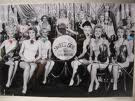
If 1934 was a breakthrough year for
Carole Lombard
with her star-making role in
Twentieth Century
, then her work in 1935 proved the previous year's performance was no fluke.
Shall we dance...again?The year started with a sequel of sorts:
Rumba, reunited Lombard with
George Raft
, her costar in
Bolero. Although not well remembered today,
Rumba was a commercial success and this time, Lombard received equal billing with Raft. If 1935 started well, it would end even better.
The Lubitsch touch Ernst Lubitsch, recently installed as production manager at Paramount, found himself working with Lombard on a property called
Hands Across the Table
. The story about a cynical manicurist, was based on "Bracelets," a story by Vina Delmar, who would go on to win an Oscar nomination, two years later, for writing the screenplay for
The Awful Truth
.
A shaky start 
The production didn't start off smoothly, however. Lubitsch was unsure of director Mitchell Leisen's ability to handle comedy material. Additionally, Lubitsch and Leisen were concerned with their inexperienced leading man, Fred MacMurray. Signed to a standard seven-year contract in 1934, MacMurray had already appeared in five films in 1935 before production on
Hands Across the Table had begun. The last film he made was
Alice Adams
, a star vehicle for Katherine Hepburn, directed by
George Stevens
. MacMurray's performance in that film received good notices, but there was some concern that he did not have the depth needed for his performance opposite Lombard. In Leisen's retelling, Lombard pitched in as almost the codirector. According to MacMurray's account, "I owe so much of that performance and my subsequent career to her [Lombard] .... She worked with me on every scene."
A new film team is born
The work paid off and the chemistry between Lombard and MacMurray was strong enough that they eventually starred in three additional films, all of which were critical and commercial successes at the time. In 1937, they starred in two films together,
The Princess Comes Across
, and
Swing High, Swing Low
, which was Paramounts biggest grossing film that year. It is interesting to note that the pairings of Hepburn and Cary Grant which are much more heralded today, were not nearly as commercially successful as the pairings of Lombard and MacMurray.
Natural beauty When
Hands Across the Table was released, the critics loved it. Many compared it to
It Happened One Night
released the year before. Some critics commented that Lombard, by eliminating the heavy makeup that she typically used, revealed a natural beauty that previously had not been seen by the movie-going public. Apparently, Lombard took note of these critiques and her future films reflect a more natural look.
With the success of
Hands Across the Table, Lombard proved she was no one-hit wonder and that she could carry a film on her own. Her career would be in high gear from hereon in.
 If 1934 was a breakthrough year for Carole Lombard
If 1934 was a breakthrough year for Carole Lombard The production didn't start off smoothly, however. Lubitsch was unsure of director Mitchell Leisen's ability to handle comedy material. Additionally, Lubitsch and Leisen were concerned with their inexperienced leading man, Fred MacMurray. Signed to a standard seven-year contract in 1934, MacMurray had already appeared in five films in 1935 before production on Hands Across the Table had begun. The last film he made was Alice Adams
The production didn't start off smoothly, however. Lubitsch was unsure of director Mitchell Leisen's ability to handle comedy material. Additionally, Lubitsch and Leisen were concerned with their inexperienced leading man, Fred MacMurray. Signed to a standard seven-year contract in 1934, MacMurray had already appeared in five films in 1935 before production on Hands Across the Table had begun. The last film he made was Alice Adams The work paid off and the chemistry between Lombard and MacMurray was strong enough that they eventually starred in three additional films, all of which were critical and commercial successes at the time. In 1937, they starred in two films together, The Princess Comes Across
The work paid off and the chemistry between Lombard and MacMurray was strong enough that they eventually starred in three additional films, all of which were critical and commercial successes at the time. In 1937, they starred in two films together, The Princess Comes Across






